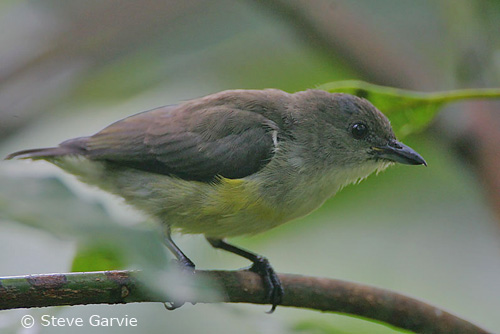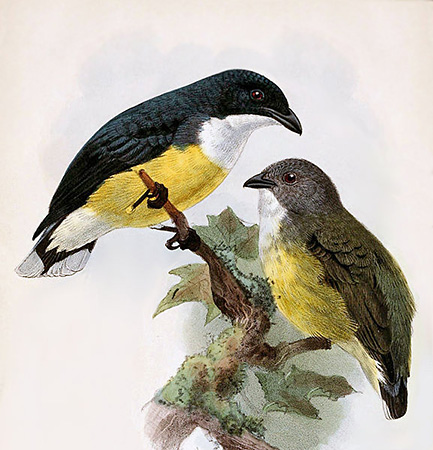
PROTECTION / THREATS / STATUS:
The White-throated Flowerpecker is mainly threatened by extensive clearance of forests, involving degradation of the habitat, especially in the wet zone where the species is living. It is caused by logging, fuelwood collection, gem mining, human settlements, fires and agriculture expansion.
The species is described as common below 900 metres and locally common up to 1,100 metres of elevation, but the population is declining due to habitat destruction.
The White-throated Flowerpecker is currently classified as Near Threatened.
Fr: Dicée de Ceylan
Ang: White-throated Flowerpecker - Legge’s Flowerpecker
All: Weißkehl-Mistelfresser
Esp: Picaflores Cingalés
Ita: Beccafiore golabianca
Nd: Ceylonese Honingvogel
Sd: ceylonblomsterpickare
Photographer:
Steve Garvie
RAINBIRDER Photo galleries
Illustrator:
John Gerrard Keulemans (1842–1912)
Illustration’s Origin: The Ibis, ser. 3, vol. 4
Text by Nicole Bouglouan
Sources:
HANDBOOK OF THE BIRDS OF THE WORLD Vol 13 by Josep del Hoyo-Andrew Elliot-Jordi Sargatal - Lynx Edicions – ISBN: 9788496553453
Fatbirder - The World’s Richest Information Resource about Birds for Birders
White-throated Flowerpecker or Legge’s Flowerpecker
Dicaeum vincens
Passeriformes Order – Dicaeidae Family
INTRODUCTION:
The White-throated Flowerpecker or Legge's Flowerpecker is endemic to Sri Lanka where it is mainly found in the wet zone, in the southwestern lowland rainforests. The name of this species pays tribute to the Australian ornithologist William Vincent Legge.
It can be seen alone, in pairs or small family groups. They usually move through the tops of tall trees in forests and adjacent areas. It descends close to the ground when feeding on fruits, berries and seeds from various plant species. It also takes insects and spiders, but it favours the nectar which is an important part of its diet.
This species breeds from January to August. The nest is a hanging pocket made of plant down, with an entrance at the top, just below the supporting branch or twig. In this genus, the female builds the nest and incubates the eggs, but both parents feed the chicks.
The White-throated Flowerpecker or Legge's Flowerpecker is threatened by clearance and forest degradation, especially in the wet zone, including some protected forests.
The species is described as common below 900 metres of elevation and locally common higher.
But currently, the White-throated Flowerpecker or Legge's Flowerpecker is classified as Near Threatened.

John Gerrard Keulemans
(1842–1912)
Male (left)
Female (right)
DESCRIPTION OF THE BIRD:
Biometrics:
Length: 10-11 cm
Weight: 8-10 g
The White-throated Flowerpecker is a very small, stout bird.
The adult male has dark blue-grey head and upperparts, but the rump is paler. On the upperwing, the feathers show narrow, slaty-blue edges. The short tail is black, with white tips to outer rectrices.
On the underparts, chin, throat and upper breast are white. Two dark blue-grey patches are visible on the sides of the breast. Lower throat and belly are yellow, becoming paler on flanks to whitish on the undertail-coverts.
The head is dark blue-grey. Chin and throat are white.
The short, thick, slightly curved bill is black with blue-grey base of lower mandible. The tongue is tubular.
The eyes are brown or reddish-brown.
Legs and feet are black.
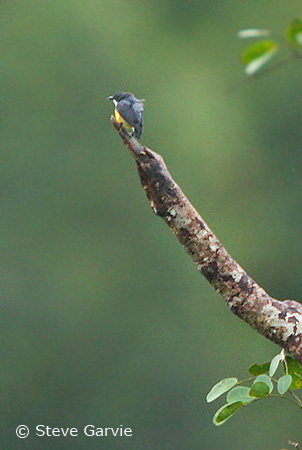
The adult female is smaller and duller than male, with grey-olive upperparts. The back is dull olive. Wings and tail are brownish-black, the latter with large white spots on outer rectrices, but less apparent than in male.
On the underparts, chin and throat are whitish. The belly is pale yellow and the flanks are olive. The underwing-coverts are white, whereas the undertail-coverts are whitish.
The juvenile resembles female but it is duller. We can see a yellow tinge on the throat. On the bill, the lower mandible is pale flesh.
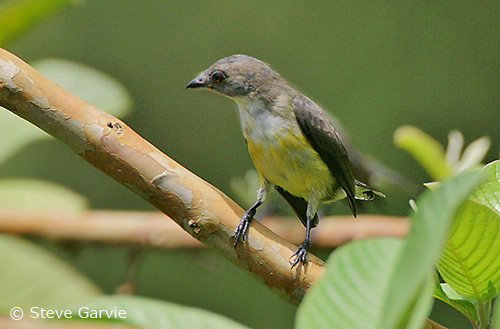
RANGE:
The White-throated Flowerpecker is endemic to Sri Lanka and occurs in the wet lowlands of the southwestern region of the island.
HABITAT:
The White-throated Flowerpecker frequents the rainforests of SW wet zone and adjacent hills, between 900 and 1,100 metres of elevation.
It usually prefers tall forests and lives mainly in the highest parts of the canopy.
However, the species has been observed in drier forest and at higher elevations. It may also visit home gardens and plantations close to primary forest, where it finds flowering and fruiting trees and shrubs.
CALLS AND SONGS: SOUNDS BY XENO-CANTO
The flowerpeckers have a considerable range of vocalizations.
The calls of the White-throated Flowerpecker include several series of sounds, frequently heard around midday, from the high treetops.
We can hear a sharp, rapid, high-pitched “kee-kee-kee-kee”, a repeated high-pitched “tee-too”, a weak “tze-tze-tze” and “wheep-wheep-wheep”.
The song is a series of 2-4 very high-pitched, thin notes “tink-tuk-tink” alternating in pitch. We can also hear an ascending “keek-keek” ending with “tit-tiri-tit-tiri”. Some rapid, irregular descending trills have also been described for this species.
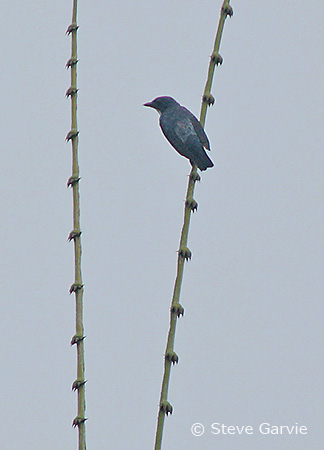
BEHAVIOUR IN THE WILD:
The White-throated Flowerpecker is a small perching bird. It feeds on nectar, fruits and wild figs, usually found high in tall trees. It also takes seeds, insects and spiders.
It has a tubular tongue, well adapted for sucking up nectar which is an important part of its diet. It especially favours the nectar of the red cotton tree of genus Bombax.
It descends to the forest floor to feed on fruits of Osbeckia (family Melastomataceae) and seeds of Freycinetia (family Pandanaceae).
Its favourite fruit is the fruit of the parasitic plant Dendrophthoe falcata (Honeysuckle mistletoe) of the family Loranthaceae.
The White-throated Flowerpecker usually forages high in trees, but also occasionally lower, close to the ground.
It forages alone, in pairs or small family groups, and it may also join mixed-feeding flocks.
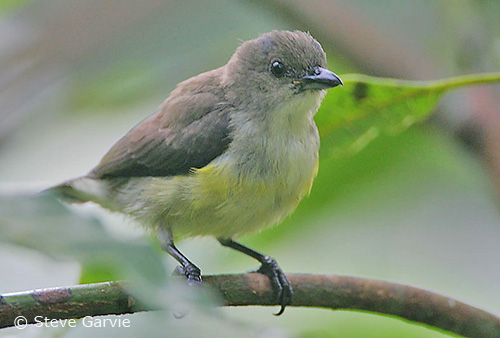
The courtship displays of this species are unknown, but some Dicaeidae species have been observed bowing the head and fanning the tail above body level. While displaying, from a dead twig or small branch near the ground, the male’s song is continuously increasing. Following this behaviour, the copulation occurs.
The nest is a pear-shaped structure suspended from branches. Both parents feed the chicks.
The White-throated Flowerpecker is an endemic resident bird in Sri Lanka.
The flowerpeckers have rather long wings and their flight is described as high and fast, with the birds frequently dipping in erratic manner.
These species are observed crossing large forest openings between forest patches. This behaviour suggests that these small birds are able to move between forest patches.
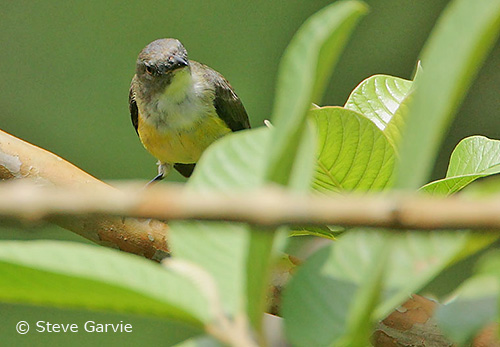
REPRODUCTION OF THIS SPECIES:
The breeding season takes place from January to August.
The White-throated Flowerpecker often builds the nest in a Hora tree (Dipterocarpus zeylanicus), a large tree that grows up to 40-50 metres tall and 4-6 m in circumference. It is usually built by the female. It is a pear-shaped/hanging pocket structure suspended from branches, with an entrance at the top forming a porch-like shelter. The nest is made of soft plant materials such as leaf buds, pieces of bark and plant down, held together with spider webs.
The female lays two pinkish-white eggs with darker spots and speckles. She incubates alone, but the duration of this period is unknown. However, in some Dicaeidae species, the incubation lasts 10-12 days and the young fledge about 15 days after hatching. Both parents feed the chicks. But more information is needed.
